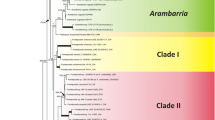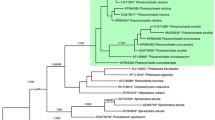Abstract
We carried out a taxonomic investigation of Echinochaete species collected from Japan and Malaysia using molecular phylogenetic analysis and morphological observations. Phylogenetic trees based on the LSU and ITS regions detected three main clades among the Echinochaete collections used in this study. The morphology of the type specimen of E. russiceps falls within the range of those collections in one of the detected clades, and we conclude that this name represents that clade. Echinochaete russiceps is characterized by aculeate to lanceolate setoid elements with lateral spines on the pileus surface, but was found to have variable pore size and pileus surface color. Another detected clade was represented by E. brachypora. The morphology of specimens in the residual clade is clearly distinct from other known species in Echinochaete and we describe this taxon as E. maximipora sp. nov. This species is characterized by the large, elongated pores (1)2–4 × (0.5)1–2 mm, cylindrical setoid elements with lateral spines on the pileus surface, and narrow basidiospores. We provide detailed descriptions of Echinochaete species in Asia and an identification key to all species of Echinochaete.






Similar content being viewed by others
References
Aoshima K, Abe Y (1983) Echinochaete ruficeps found in Japan. Proceedings of the 27th annual meeting of the Mycological Society of Japan. Abstracts of submitted papers. p 61 (abstract)
Bondartsev AS, Singer R (1941) Zur Systematik der Polyporaceen. Ann Mycol 39:43–65
Corner EJH (1984) Ad Polyporaceas II. Polyporus, Mycobonia, and Echinochaete. Beih Nova Hedwig 78:1–129
Cunningham GH (1965) Polyporaceae of New Zealand. N Z Dep Sci Ind Res Bull 164:1–304
Donk MA (1960) The generic names proposed for Polyporaceae. Persoonia 1:173–302
Farris JS, Källersjö M, Kluge AG, Bult C (1994) Testing significance of incongruence. Cladistics 10:315–319 doi:10.1111/j.1096-0031.1994.tb00181.x
Käärik A (1965) The identification of the mycelia of wood-decay fungi by their oxidation reactions with phenolic compounds. Bibliot Mycol 81:1–151
Kiet TT (1996) Danh Luc Nam Lon Cua Ciet Nam. Nha Xuat Ban Nong Nghiep, HaNoi
Nobles MK (1965) Identification of cultures of wood inhabiting Hymenomycetes. Can J Bot 43:1097–1139
Núñez M, Ryvarden L (1995) Polyporus (Basidiomycotina) and related genera. Synopsis Fungorum 10:1–85
Núñez M, Ryvarden L (2001) East Asian Polypores Vol. 2. Fungiflora, Oslo
Reid DA (1963) New or interesting records of Australian Basidiomycetes. V. Kew Bull 17:267–308
Ryvarden L (1978) Studies in the Aphyllophorales of Africa 6. Some species from eastern Central Africa. Bull Jard Bot Nat Belg 48:79–117
Ryvarden L, Johansen I (1980) A preliminary polypore flora of East Africa. Fungiflora, Oslo
Silveira RMB, Wright JE (2005) The taxonomy of Echinochaete and Polyporus s. str. in South America. Mycotaxon 93:1–59
Sotome K, Hattori T, Ota Y, To-anun C, Salleh B, Kakishima M (2008) Phylogenetic relationships of Polyporus and morphologically allied genera. Mycologia 100(4):603–615
Swofford DL (2003) PAUP 4.0b10: phylogenetic analysis using parsimony. Sinauer Associates, Sunderland, MA
Thompson JD, Gibson TJ, Plewniak F, Jeanmougin F, Higgins DG (1997) The CLUSTAL_X windows interface: flexible strategies for multiple sequence alignment aided by quality analysis tools. Nucleic Acids Res 25:4876–4882
White TJ, Bruns TD, Lee S, Taylor J (1990) Amplification and direct sequencing of fungal ribosomal DNA genes for phylogenies. In: Innis MA, Gelfand DH, Snisky JJ, White TJ (eds) PCR protocols, a guide to methods and applications. Academic Press, San Diego, pp 315–322
Wu SH, Ryvarden L (2003) Polypore fungi newly recorded from Taiwan. Mycotaxon 85:101–108
Zhao JD (1998) Flora fungorum sinicorum Vol. 3, Polyporaceae. Science Press, Beijing
Acknowledgements
We are grateful to Y. Ando, S. Kurogi, H. Sasaki, K. Tsujiyama and S. Tsujiyama (Kyoto Prefectural University) for kindly providing specimens. We are grateful to the curator of Royal Botanic Gardens, Kew (K) for the loan of type material. We are grateful for the help of anonymous reviewers for comments on the manuscript. K.S. acknowledges financial support from the Japan Society for the Promotion of Science (JSPS). This research was supported by Research Fellowships for Young Scientists (No. 19-2260) from JSPS.
Author information
Authors and Affiliations
Corresponding author
Additional information
Contribution No. 220, Laboratory of Plant Parasitic Mycology, Graduate School of Life andEnvironmental Science, University of Tsukuba, Japan.
Rights and permissions
About this article
Cite this article
Sotome, K., Hattori, T., Ota, Y. et al. Taxonomic study of Asian species of Echinochaete (Polyporaceae, Basidiomycota) and description of E. maximipora sp. nov.. Mycol Progress 8, 123–132 (2009). https://doi.org/10.1007/s11557-009-0584-6
Received:
Revised:
Accepted:
Published:
Issue Date:
DOI: https://doi.org/10.1007/s11557-009-0584-6




